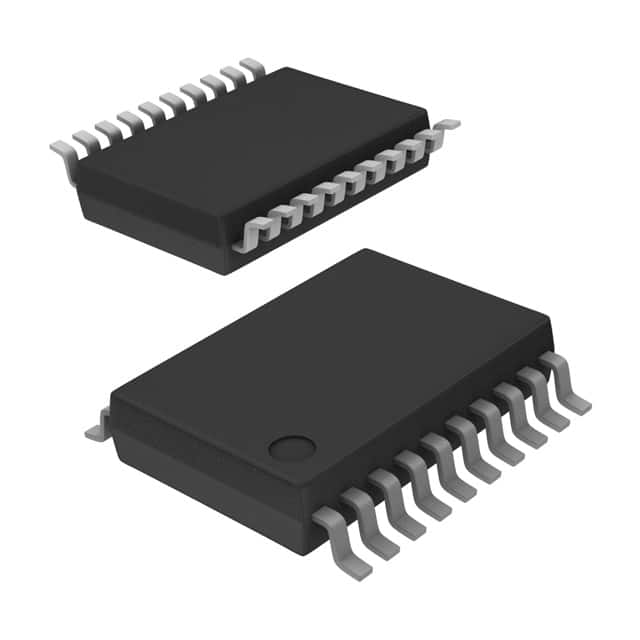Consulte las especificaciones para obtener detalles del producto.

SN74LVCH245ADBRE4
Product Overview
- Category: Integrated Circuit (IC)
- Use: Level Shifter and Bus Transceiver
- Characteristics: Low-Voltage, High-Speed, Octal Bus Transceiver
- Package: SSOP (Shrink Small Outline Package)
- Essence: Bidirectional Voltage-Level Translation
- Packaging/Quantity: Tape and Reel, 2500 pieces per reel
Specifications
- Supply Voltage Range: 1.65V to 3.6V
- Input Voltage Range: 0V to VCC
- Output Voltage Range: 0V to VCC
- High-Level Input Voltage: 0.7 x VCC to VCC
- Low-Level Input Voltage: 0V to 0.8 x VCC
- High-Level Output Voltage: 0.9 x VCC to VCC
- Low-Level Output Voltage: 0V to 0.1 x VCC
- Maximum Operating Frequency: 400MHz
- Number of Channels: 8
Detailed Pin Configuration
The SN74LVCH245ADBRE4 has a total of 20 pins. The pin configuration is as follows:
- OE (Output Enable) - Active Low Output Enable
- A1 - Data Input/Output for Channel 1
- B1 - Data Input/Output for Channel 1
- A2 - Data Input/Output for Channel 2
- B2 - Data Input/Output for Channel 2
- A3 - Data Input/Output for Channel 3
- B3 - Data Input/Output for Channel 3
- GND (Ground) - Ground Reference
- B4 - Data Input/Output for Channel 4
- A4 - Data Input/Output for Channel 4
- B5 - Data Input/Output for Channel 5
- A5 - Data Input/Output for Channel 5
- B6 - Data Input/Output for Channel 6
- A6 - Data Input/Output for Channel 6
- B7 - Data Input/Output for Channel 7
- A7 - Data Input/Output for Channel 7
- B8 - Data Input/Output for Channel 8
- A8 - Data Input/Output for Channel 8
- VCC - Power Supply Voltage
- DIR (Direction Control) - Direction Control Input
Functional Features
- Bidirectional voltage-level translation between two different voltage domains.
- Allows interfacing between devices operating at different voltage levels.
- Provides a seamless data transfer between systems with different voltage requirements.
- Supports both push-pull and open-drain output configurations.
- Low power consumption and high-speed operation.
Advantages and Disadvantages
Advantages: - Enables communication between devices with different voltage levels. - High-speed operation allows for efficient data transfer. - Low power consumption helps in reducing overall system power requirements.
Disadvantages: - Limited to a maximum operating frequency of 400MHz. - May require additional external components for certain applications.
Working Principles
The SN74LVCH245ADBRE4 is designed to facilitate bidirectional voltage-level translation. It operates by monitoring the input voltage levels and translating them to the appropriate output voltage levels based on the direction control input. The device uses a combination of MOSFETs and logic circuitry to achieve this voltage translation.
Detailed Application Field Plans
The SN74LVCH245ADBRE4 finds applications in various fields, including:
- Microcontroller Interfacing: It enables communication between microcontrollers operating at different voltage levels.
- Sensor Networks: Facilitates data exchange between sensors and microcontrollers with varying voltage requirements.
- Industrial Automation: Allows for seamless integration of different control systems operating at different voltage levels.
- Consumer Electronics: Enables communication between devices such as smartphones, tablets, and peripherals with different voltage specifications.
Detailed and Complete Alternative Models
- SN74LVC245A: Similar functionality but operates at a higher supply voltage range (1.65V to 5.5V).
- SN74LVCH244A: Octal buffer/line driver with similar voltage-level translation capabilities.
- SN74LVC4245A: Dual-supply translating transceiver with additional direction control features.
These alternative models provide similar functionality to the SN74LVCH245ADBRE4 but may have different specifications and pin configurations.
Word count: 470 words
Enumere 10 preguntas y respuestas comunes relacionadas con la aplicación de SN74LVCH245ADBRE4 en soluciones técnicas
Sure! Here are 10 common questions and answers related to the application of SN74LVCH245ADBRE4:
Q: What is SN74LVCH245ADBRE4? A: SN74LVCH245ADBRE4 is a non-inverting octal bus transceiver with 3-state outputs, designed for low-voltage (1.65V to 3.6V) applications.
Q: What is the purpose of SN74LVCH245ADBRE4? A: SN74LVCH245ADBRE4 is used to enable bidirectional level shifting between two buses operating at different voltage levels.
Q: What is the maximum data transfer rate supported by SN74LVCH245ADBRE4? A: SN74LVCH245ADBRE4 supports a maximum data transfer rate of 400 Mbps.
Q: Can SN74LVCH245ADBRE4 be used in both 5V and 3.3V systems? A: Yes, SN74LVCH245ADBRE4 can be used in both 5V and 3.3V systems as it has a wide operating voltage range.
Q: How many channels does SN74LVCH245ADBRE4 have? A: SN74LVCH245ADBRE4 has 8 bidirectional channels, allowing for simultaneous data transmission in both directions.
Q: Does SN74LVCH245ADBRE4 support hot insertion? A: Yes, SN74LVCH245ADBRE4 is designed to support hot insertion, which means it can be inserted or removed from a live circuit without causing damage.
Q: Can SN74LVCH245ADBRE4 handle high-speed signals? A: Yes, SN74LVCH245ADBRE4 is designed to handle high-speed signals and is suitable for applications requiring fast data transfer.
Q: What is the power supply voltage range for SN74LVCH245ADBRE4? A: SN74LVCH245ADBRE4 operates with a power supply voltage range of 1.65V to 3.6V.
Q: Does SN74LVCH245ADBRE4 have built-in ESD protection? A: Yes, SN74LVCH245ADBRE4 has built-in ESD protection, which helps safeguard against electrostatic discharge events.
Q: Can SN74LVCH245ADBRE4 be used in automotive applications? A: Yes, SN74LVCH245ADBRE4 is qualified for automotive applications and meets the necessary industry standards.
Please note that these answers are general and may vary depending on specific application requirements. It's always recommended to refer to the datasheet and consult the manufacturer for detailed information.

